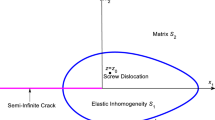Summary
A closed-form analytical solution is given for the stress field due to a screw dislocation interacting with nearby inclusions (the fibers) in a fiber-reinforced composite material. The dislocation is assumed near one of the inclusions, while the influence of other surrounding inclusions on the dislocation is taken into consideration through the three-phase composite cylinder model. The formulation procedure is based on the Muskhelishvili complex variable method of elasticity theory. The force on the dislocation is then derived. It is shown that, in comparison with the two-phase model adopted by Dundurs, the three-phase model allows the dislocation to have equilibrium positions near the fiber.
Similar content being viewed by others
References
Erdogan, F., Gupta, G. D., Ratwani M.: Interaction between a circular inclusion and an arbitrarily oriented crack. ASME J. Appl. Mech.41, 1007–1013 (1974).
Nisitani, H., Chen, D. H., Saimoto, A.: Interaction between an elliptic inclusion and a crack. Proc. Int. Conference on Computer-Aided Assessment and Control, Computational Mechanics Inc, MA, USA,4, pp. 325–332 (1996).
Xiao, Z. M., Chen, B. J.: Stress intensity factor for a Griffith crack interacting with a coated inclusion. Int. J. Fract. (in press).
Dundurs, J., Mura, T.: Interaction between an edge dislocation and a circular inclusion. J. Mech. Phys. Solids12, 177–189 (1964).
Dundurs, J., Sendeckyi, G. P.: Edge dislocation inside a circular inclusion. J. Mech. Phys. Solids13, 141–147 (1965).
Dundurs, J.: On the interaction of a screw dislocation with inhomogeneities. Recent Adv. Engng Sci.2, 223–233 (1967).
Stagni, L., Lizzio, R.: Shape effects in the interaction between an edge dislocation and an elliptic inclusion. J. Appl. Phys.A30, 217–221 (1993).
Warren, W. E.: The edge dislocation inside an elliptic inclusion. Mech. Mat.2, 319–330 (1983).
Worden, R. E., Keer, L. M.: Green's functions for a point load and dislocation in an annular region. ASME J. Appl. Mech.58, 954–959 (1991).
Gong, S. X., Meguid, S. A.: Screw dislocation interacting with an elastic elliptical inhomogeneity. Int. J. Engng Sci.32, 1221–1228 (1994).
Christensen, R. M., Lo, K. H.: Solution for effective shear properties in three-phase sphere and cylinder models. J. Mech. Phys. Solids27, 315–330 (1979).
Christensen, R. M.: Mechanics of composite materials. New York: Wiley 1979.
Luo, H. A., Chen, Y.: An edge dislocation in a three-phase composite cylinder model. ASME J. Appl. Mech.58, 75–86 (1991).
Author information
Authors and Affiliations
Rights and permissions
About this article
Cite this article
Xiao, Z.M., Chen, B.J. A screw dislocation interacting with inclusions in fiber-reinforced composites. Acta Mechanica 155, 203–214 (2002). https://doi.org/10.1007/BF01176243
Received:
Issue Date:
DOI: https://doi.org/10.1007/BF01176243




